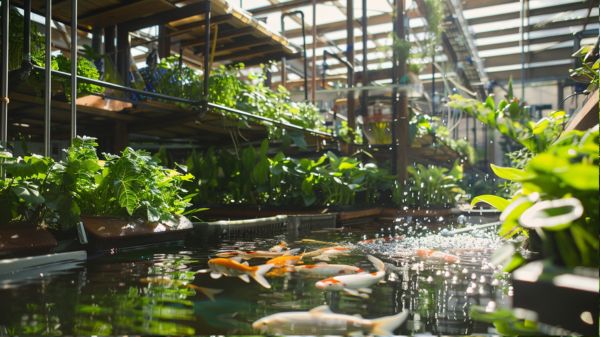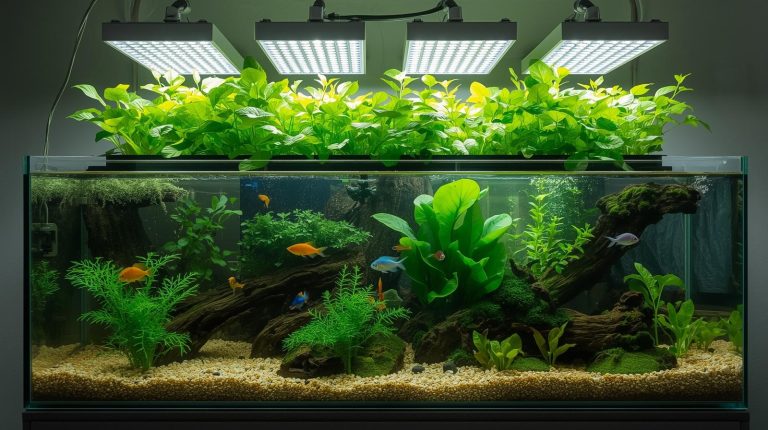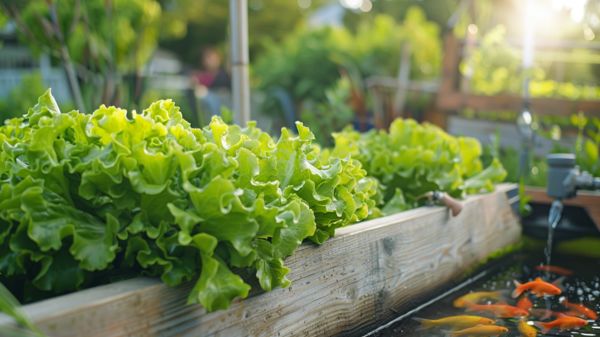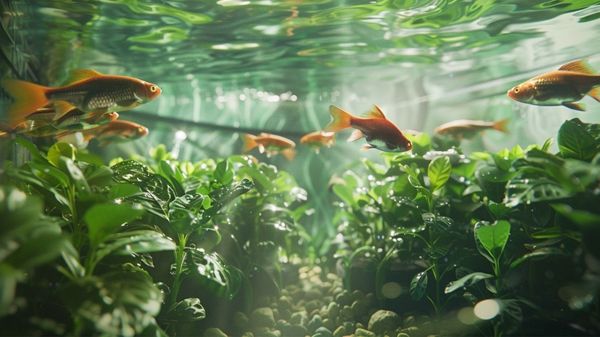Exploring innovative DIY aquaponics system design plans opens up a myriad of possibilities for sustainable gardening enthusiasts. From the efficient use of indoor space with Shelponics to the practical repurposing of IBC containers in the Chop and Flip method, each approach offers unique advantages.
The modular nature of Survival Gardeners’ Aquaponics allows for easy customization, while using reclaimed materials for a greenhouse underscores environmental stewardship. These creative ideas not only maximize space and promote sustainability but also foster a self-sustaining ecosystem for both plants and fish.
What other ingenious solutions could further enhance these systems?
Key Takeaways
- Repurpose bookshelves for indoor vertical space-efficient aquaponics with a recirculating pump.
- Utilize IBC containers for modular fish tanks and grow beds in a scalable setup.
- Create a sustainable greenhouse aquaponics system using reclaimed materials and a 200-gallon tank.
- Design small space aquaponics using vertical structures for efficient water use and compact food production.
- Assemble a cost-efficient bathtub aquaponics system for versatile plant growing and easy scalability.
DIY Indoor Shelponics
Designing a DIY indoor shelponics system involves utilizing multi-layered bookshelves to efficiently integrate aquaponics into small indoor spaces, providing a functional and aesthetic solution for growing herbs and vegetables. This innovative approach leverages vertical space, making it ideal for lounge areas or kitchens where horizontal space is often limited.
Begin by selecting a sturdy bookshelf with at least four tiers. This structure serves as the backbone of your indoor aquaponics setup. Each shelf will house a grow bed filled with a growth medium like expanded clay pellets or gravel, which supports plant roots and facilitates nutrient absorption.
Beneath each grow bed, install a small water reservoir connected to a recirculating pump. The pump’s role is to continuously cycle nutrient-rich water from a fish tank positioned at the base of the bookshelf to the plants above.
For optimum efficiency, use a timer to automate the water flow, ensuring plants receive adequate moisture and nutrients without manual intervention. LED grow lights can be mounted on the underside of each shelf to provide necessary light for photosynthesis, especially in low-natural-light environments.
Customization is key; adapt the shelf dimensions and plant selection to fit your specific needs and preferences.
Chop and Flip IBC System
The Chop and Flip IBC System, an advanced technique for aquaponics enthusiasts, repurposes Intermediate Bulk Containers (IBCs) into robust fish tanks and grow beds, optimizing both space and resource utilization. This innovative system leverages the inherent durability of IBC containers, which are supported by sturdy metal frames, ensuring a long-lasting and efficient aquaponics setup.
The design features a two-part configuration, meticulously separating the fish tank from the grow beds. This separation is essential for maintaining ideal conditions for both aquatic life and plant growth. The fish tank, constructed from the lower section of the IBC, provides a spacious environment for fish, while the upper section is transformed into grow beds, facilitating nutrient-rich plant cultivation.
Detailed tutorials by Rob Bobs Aquaponics & Backyard Farm offer in-depth guidance on constructing this system, emphasizing precision and efficiency. These tutorials empower individuals to harness the full potential of the Chop and Flip IBC System, maximizing space utilization and creating a robust foundation for sustainable plant growth.
This system embodies a blend of practicality and ingenuity, liberating aquaponics enthusiasts to achieve higher productivity within a compact footprint.
Survival Gardeners’ Aquaponics
Leveraging the versatility of three Intermediate Bulk Containers (IBCs), Survival Gardeners’ aquaponics system offers a cost-effective and scalable solution for sustainable fish and plant cultivation.
This DIY Aquaponics System utilizes IBC containers to create an integrated setup comprising a fish tank, grow beds, and a sump tank. Each component plays a critical role in maintaining a balanced ecosystem.
The fish tank, typically the largest IBC container, houses the aquatic life. Waste produced by the fish becomes a nutrient-rich input for the plants.
The grow beds, formed by cutting IBC containers in half, serve as the cultivation area for plants. These grow beds are filled with a growing medium that provides support and enhances nutrient uptake through a process known as biofiltration.
The sump tank, usually positioned at the lowest point, collects water after it has cycled through the system, ready to be pumped back into the fish tank.
This setup is particularly advantageous for beginners due to its simplicity and modular nature. The use of IBC containers allows for ample space and easy customization. Additionally, this design is inherently expandable, enabling enthusiasts to scale the system according to their needs and available space, empowering individuals to achieve self-sufficiency through sustainable aquaponics.
Greenhouse From Reclaimed Materials
Building a greenhouse from reclaimed windows and doors not only enhances sustainability but also greatly decreases costs. It is vital to guarantee the structural integrity of these materials, requiring careful inspection and reinforcement where necessary.
Incorporating a 200-gallon aquaponics system within this structure demands thoughtful planning to maximize space, support weight, and uphold environmental control for year-round vegetable cultivation.
Sourcing Reclaimed Windows
Sourcing reclaimed windows from salvage yards, construction sites, or online marketplaces is a strategic approach to building a sustainable and cost-effective greenhouse. Utilizing reclaimed windows not only reduces waste but also leverages existing materials to create an efficient and aesthetic structure ideal for aquaponics.
Reclaimed windows offer several benefits:
- Natural Light: They provide ample sunlight, essential for plant growth within the greenhouse.
- Insulation: Many older windows are double-glazed, offering better insulation and maintaining ideal temperatures.
- Cost-Effectiveness: Reusing materials lowers the overall cost compared to purchasing new windows.
- Sustainability: This practice supports the recycling of materials, contributing to environmental conservation.
- Unique Aesthetics: Each reclaimed window adds a rustic and unique charm to the greenhouse structure.
When sourcing reclaimed windows, it is important to inspect them for structural integrity, ensuring they can withstand the conditions within an aquaponics greenhouse.
Look for windows that are free from significant cracks or damage and verify they can be securely installed to prevent heat loss and maintain a controlled environment for your aquaponics system.
By carefully selecting and repurposing these windows, you can create a greenhouse that is not only functional but also embodies the principles of sustainability and innovation.
Structural Integrity Considerations
Securing the structural integrity of a greenhouse built from repurposed materials necessitates thorough inspection and strengthening of each part to withstand environmental pressures and support the aquaponics system.
Begin by carefully examining every reclaimed window and door for indications of decay, bending, or structural fragility. Strengthen any compromised areas with sturdy materials like treated lumber or metal brackets to guarantee stability.
To improve the durability of your greenhouse, utilize top-notch, weather-resistant sealants to fasten joints and connections, preventing water infiltration that could degrade the framework over time. Furthermore, consider fortifying the frame with cross-bracing methods, which offer additional resistance against wind and snow loads.
The foundation is another crucial element; a firm base not only upholds the greenhouse’s weight but also the incorporated 200-gallon aquaponics system. Choose a concrete slab or a well-compacted gravel base to evenly distribute the load and prevent sinking.
Lastly, incorporating repurposed materials into your greenhouse layout not only advocates for eco-friendliness and sustainability but also enables ample natural light, crucial for plant growth within the aquaponics system.
Properly designed, a repurposed-material greenhouse can serve as a resilient and effective environment for your aquaponics initiatives.
Integrating Aquaponics System
After securing the structural integrity of the greenhouse, the next step involves methodically integrating the 200-gallon aquaponics system to optimize the synergy between plant and fish cultivation. This integration leverages the sustainable approach of using reclaimed materials, offering both environmental benefits and functional efficiency.
The following steps ensure a seamless installation and operation:
- Positioning: Strategically place the aquaponics system within the greenhouse to maximize sunlight exposure and space efficiency. This guarantees both the plants and fish receive ideal conditions for growth.
- Plumbing: Install a robust plumbing network to facilitate water circulation between the fish tank and the grow beds. Utilize durable, eco-friendly materials to minimize maintenance and environmental impact.
- Aeration: Implement an efficient aeration system to maintain oxygen levels essential for fish health and plant root development. Consider solar-powered pumps to enhance sustainability.
- Water Quality Monitoring: Regularly monitor water parameters such as pH, ammonia, and nitrate levels. Employ automated sensors for real-time data collection and adjustments.
- Plant and Fish Selection: Choose plant and fish species that complement each other’s needs, ensuring a balanced ecosystem. Common choices include leafy greens and tilapia.
Easy Aquarium Aquaponics
Utilizing an existing fish tank for plant growth, easy aquarium aquaponics offers a simple approach to creating a symbiotic ecosystem where fish and plants mutually benefit. This design capitalizes on the natural relationship between aquatic life and vegetation, making it an ideal entry point for beginners.
By installing a grow bed on top of the aquarium, one can transform a basic fish tank into a self-sustaining system. The fish generate waste, rich in nutrients, which is then cycled to the plants. In turn, the plants filter the water, creating a balanced environment for the fish.
The setup process is remarkably straightforward. Begin by selecting a compatible grow bed that fits securely over the aquarium. The grow bed should contain a growing medium, such as expanded clay pellets, which will support the plants and facilitate nutrient absorption. Water pumps and aeration systems are essential to ensure proper water flow and oxygen levels, crucial for both fish and plant health.
Online resources offer detailed step-by-step tutorials, providing in-depth guidance on assembling and maintaining an aquarium aquaponics system. This approach not only promotes sustainability but also encourages a deeper understanding of ecological interdependence, ultimately offering a practical and freeing gardening solution.
Bathtub Aquaponics System
Transforming a recycled bathtub into a functional aquaponics system offers a cost-effective and innovative solution for sustainable home gardening. By repurposing an old bathtub, enthusiasts can create a robust system conducive to growing a variety of herbs, vegetables, or flowers. The large space of the bathtub provides ample room for plant roots to spread and thrive, while simultaneously housing the necessary aquatic environment for fish.
Key benefits and components of a bathtub aquaponics system include:
- Cost Efficiency: Utilizing a recycled bathtub minimizes initial setup costs and promotes environmental sustainability.
- Versatility: The sizable container allows for a diverse range of plants to grow, accommodating both small and large species.
- Ease of Setup: Bathtubs are straightforward to convert into aquaponics systems, making them ideal for beginners and hobbyists.
- Scalability: This system can be easily expanded or modified for larger-scale aquaponics projects as needed.
- Sustainable Water Use: The closed-loop system efficiently recycles water, reducing waste and conserving resources.
To set up, first make sure the bathtub is thoroughly cleaned. Install a grow bed above the tub where the plants will be situated. A submersible pump will circulate water from the fish tank to the grow bed, facilitating a natural nutrient cycle. This synergy between aquatic and plant life fosters a thriving, self-sustaining ecosystem.
Small Space Aquaponics
Small space aquaponics systems leverage vertical structures, such as towers and A-frames, to maximize plant growth in limited areas, utilizing efficient water circulation methods to support both fish and plants.
Indoor setups can be optimized using modular components like bookshelves, enabling the cultivation of herbs and leafy greens in constrained environments.
Additionally, balcony systems crafted from PVC pipes and net cups offer a compact yet productive solution for urban gardening enthusiasts.
Compact System Designs
Compact aquaponics systems, tailored for limited spaces such as apartments and balconies, employ innovative designs that integrate smaller fish tanks and grow beds to optimize the available area. These systems are particularly adept at accommodating various types of aquaponics systems, including media bed, nutrient film technique (NFT), and vertical towers, to grow plants efficiently in confined environments.
To maximize the utility of compact spaces, you can employ several advanced techniques:
- Vertical Stacking: Utilizing vertical space with tiered shelving or vertical towers to increase the planting area without expanding the footprint.
- Compact Fish Tanks: Using smaller, high-density fish tanks that still maintain ideal water quality and nutrient levels.
- Integrated Grow Beds: Combining grow beds directly on top of or adjacent to fish tanks to create a cohesive unit.
- Efficient Lighting: Implementing energy-saving LED grow lights tailored to the specific needs of herbs, leafy greens, or small vegetables.
- Automated Systems: Incorporating automated monitoring and control systems for water quality, temperature, and nutrient levels to ensure top-notch plant growth and fish health.
Indoor Plant Growth
Leveraging the principles of aquaponics, indoor plant growth systems for small spaces provide an innovative solution for cultivating a variety of herbs, vegetables, and decorative plants efficiently within confined environments.
These systems harness the symbiotic relationship between aquatic animals and plants, wherein fish waste provides essential nutrients that facilitate robust plant growth. By integrating fish tanks with grow beds, the process ensures a continuous supply of nutrient-rich water that recycles through the system.
Indoor aquaponics systems are particularly advantageous in settings such as apartments and offices where traditional gardening is impractical. You can tailor them to fit diverse design aesthetics, making them both functional and visually appealing. Techniques like vertical stacking and using LED grow lights maximize space utilization and ensure ideal light conditions for photosynthesis, thereby enhancing plant productivity.
Advanced methods such as biofiltration and automated water quality monitoring further augment system efficiency. These techniques ensure that both fish and plants thrive, creating a balanced ecosystem.
The ability to customize these systems allows for the cultivation of a wide range of plant species, providing fresh produce and greenery year-round. This not only contributes to a sustainable lifestyle but also transforms limited spaces into green havens.
Efficient Water Use
Efficient water use in small space aquaponics systems is achieved through the continuous recycling of water between the fish tank and grow beds, significantly reducing water consumption by up to 90% compared to traditional soil gardening. This closed-loop system ensures that water loss is minimized, making it ideal for urban dwellers or those with limited outdoor space.
Incorporating advanced techniques such as the nutrient film technique (NFT) further optimizes water efficiency. NFT involves a thin film of nutrient-rich water flowing over the roots of plants, guaranteeing they receive adequate nutrients while conserving water. A reliable water pump is essential for maintaining this constant flow, making sure to recycle water continuously between the fish tank and grow beds.
Key benefits of efficient water use in small space aquaponics include:
- Minimal water waste due to continuous recycling.
- Enhanced plant growth through nutrient-rich water supply.
- Sustainable food production in compact living environments.
- Reduced reliance on external water sources.
- Lower operational costs due to water savings.
Related Post: 8 Best Indoor Aquaponics Fish Tank Systems for Sustainable Home Gardening.
Beginner Backyard Aquaponics
For those new to aquaponics, beginner backyard systems offer a practical and manageable way to integrate fish farming and hydroponic plant cultivation into a cohesive, symbiotic environment.
These systems typically comprise a fish tank, a grow bed, a water pump, and a plumbing setup, all designed for straightforward operation and maintenance. The integration of fish and plants is key, as fish waste provides essential nutrients for plant growth, while plants help filter and clean the water for the fish.
Popular choices for the fish tank include tilapia and goldfish, known for their hardiness and suitability for small systems. In the grow bed, plants such as lettuce, herbs, and cherry tomatoes thrive, ensuring a steady supply of fresh produce. The water pump circulates nutrient-rich water from the fish tank to the grow bed, where plants absorb these nutrients and return filtered water back to the fish.
| Component | Description | Purpose |
|---|---|---|
| Fish Tank | Home for fish like tilapia and goldfish | Produces nutrient-rich waste for plants |
| Grow Bed | Filled with media for plant support | Cultivates plants, filters water |
| Water Pump | Circulates water between tank and grow bed | Guarantees nutrient distribution and water flow |
| Plumbing Setup | Connects all components | Maintains system integrity and efficiency |
One Barrel Aquaponics System
A one barrel aquaponics system, often favored for its simplicity and cost-efficiency, serves as an excellent introduction to the principles of aquaponics for beginners. Utilizing just a single barrel, a drill, and a jigsaw, this compact system offers an efficient method to grow plants by leveraging fish waste as nutrients.
The design revolves around a closed-loop system where fish waste provides essential nutrients for the plants, while the plants help filter and purify the water for the fish—ensuring a symbiotic relationship that enhances growth and sustainability. Key to the system’s success is the precise management of water flow, ensuring ideal oxygenation and nutrient distribution.
Key features include:
- Compact Design: Perfect for small spaces, making it ideal for urban environments.
- Cost-Efficient: Minimal initial investment required, reducing financial barriers.
- Scalability: Easily expanded or customized based on available space and needs.
- Hands-On Learning: Provides practical experience in aquaponics system management.
- Sustainability: Utilizes natural processes to create a self-sustaining ecosystem.
Conclusion
The exploration of various DIY aquaponics system designs, such as Shelponics, the Chop and Flip IBC System, and Survival Gardeners’ Aquaponics, demonstrates a commitment to space efficiency, sustainability, and modular customization.
Implementing reclaimed materials in greenhouse construction and diverse systems like the One Barrel and Bathtub Aquaponics further enhances ecological benefits.
These designs collectively provide robust frameworks for developing self-sustaining ecosystems, suitable for varying skill levels and spatial constraints in aquaponics cultivation.




